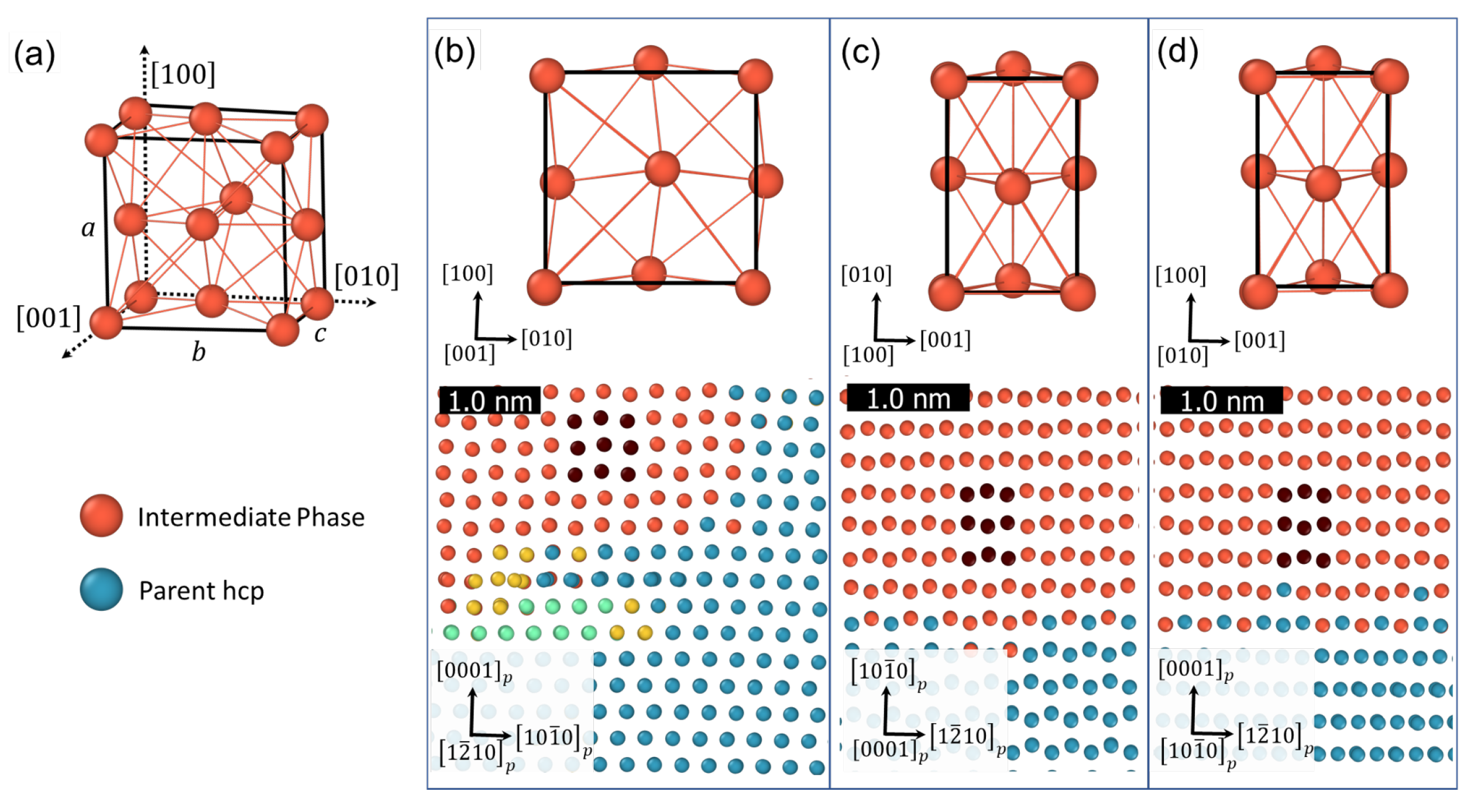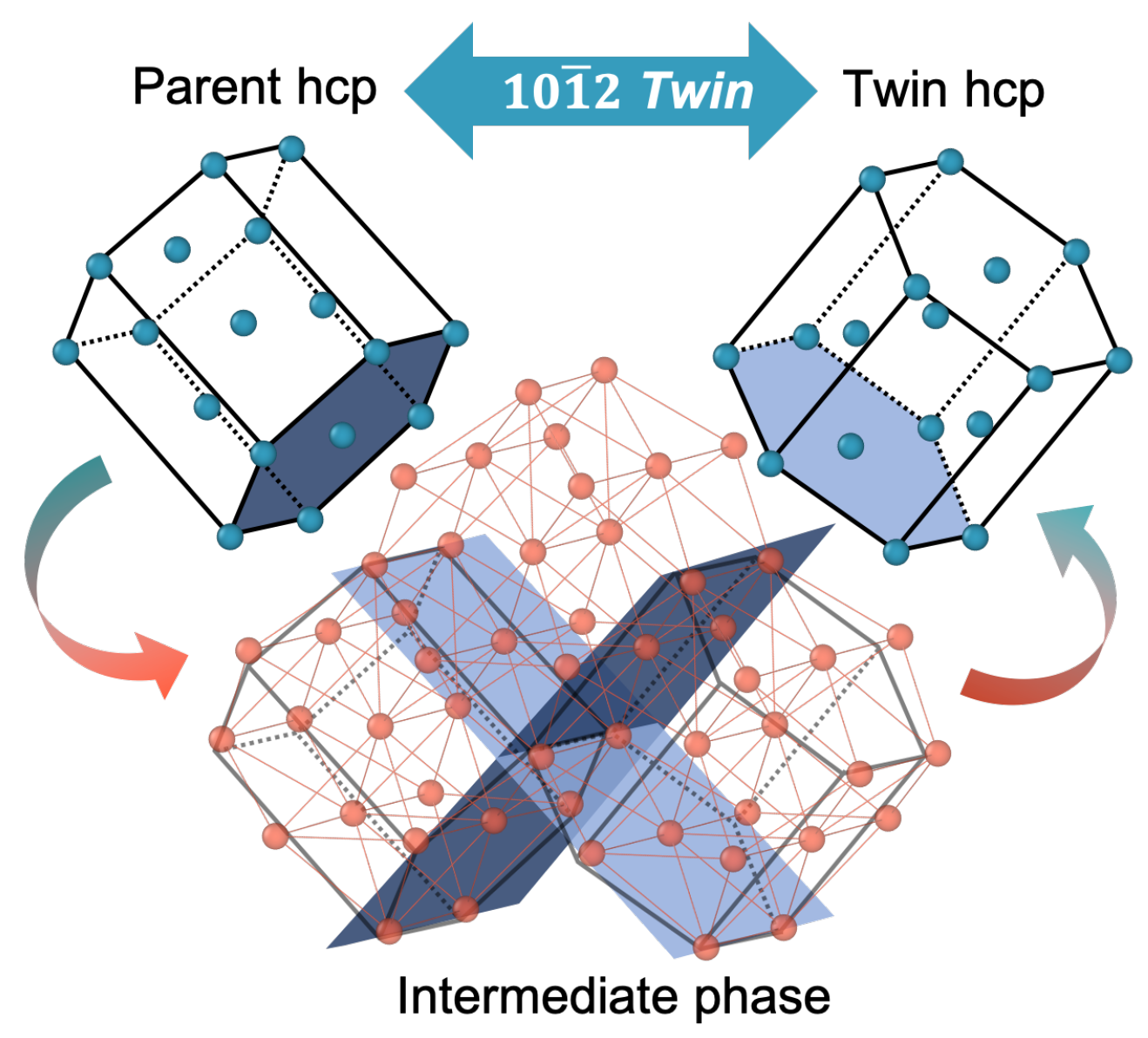Nucleation of {1012} Twins in Magnesium through Reversible Martensitic Phase Transformation
Abstract
1. Introduction
2. Methodology
3. Results and Discussion
3.1. The Formation of Twins
3.2. Detailed Structure of the Tetragonal Phase
3.3. Orientation Relation
3.4. The Atomic Motion in the Martensitic Phase Transformation-Mediated Twinning Mechanism
4. Conclusions
Author Contributions
Funding
Conflicts of Interest
References
- Yoo, M.H. Slip, twinning, and fracture in hexagonal close-packed metals. Metall. Trans. A 1981, 12, 409–418. [Google Scholar] [CrossRef]
- Sivanandini, M.; Dhami, S.S.; Pabla, B.S. Formability of magnesium alloys. Int. J. Mod. Eng. Res. 2012, 2, 2464–2471. [Google Scholar]
- Barnett, M.R. Twinning and the ductility of magnesium alloys: Part I: “Tension” twins. Mater. Sci. Eng. A 2007, 464, 1–7. [Google Scholar] [CrossRef]
- Barnett, M.R. Twinning and the ductility of magnesium alloys: Part II: “Contraction” twins. Mater. Sci. Eng. A 2007, 464, 8–16. [Google Scholar] [CrossRef]
- Christian, J.W.; Mahajan, S. Deformation twinning. Prog. Mater. Sci. 1995, 39, 1–157. [Google Scholar] [CrossRef]
- Xin, Y.; Wang, M.; Zeng, Z.; Nie, M.; Liu, Q. Strengthening and toughening of magnesium alloy by 10–12 extension twins. Scr. Mater. 2012, 66, 25–28. [Google Scholar] [CrossRef]
- Xin, R.; Guo, C.; Xu, Z.; Liu, G.; Huang, X.; Liu, Q. Characteristics of long 10–12 twin bands in sheet rolling of a magnesium alloy. Scr. Mater. 2014, 74, 96–99. [Google Scholar] [CrossRef]
- Mokdad, F.; Chen, D.L.; Li, D.Y. Twin-twin interactions and contraction twin formation in an extruded magnesium alloy subjected to an alteration of compressive direction. J. Alloys Compd. 2018, 737, 549–560. [Google Scholar] [CrossRef]
- Li, B.; Ma, E. Atomic shuffling dominated mechanism for deformation twinning in magnesium. Phys. Rev. Lett. 2009, 103, 035503. [Google Scholar] [CrossRef]
- Wang, J.; Yadav, S.K.; Hirth, J.P.; Tomé, C.N.; Beyerlein, I.J. Pure-shuffle nucleation of deformation twins in hexagonal-close-packed metals. Mater. Res. Lett. 2013, 1, 126–132. [Google Scholar] [CrossRef]
- Chen, P.; Li, B.; Culbertson, D.; Jiang, Y. Contribution of extension twinning to plastic strain at low stress stage deformation of a Mg-3Al-1Zn alloy. Mater. Sci. Eng. A 2018, 709, 40–45. [Google Scholar] [CrossRef]
- Beyerlein, I.J.; Capolungo, L.; Marshall, P.E.; McCabe, R.J.; Tomé, C.N. Statistical analyses of deformation twinning in magnesium. Philos. Mag. 2010, 90, 2161–2190. [Google Scholar] [CrossRef]
- Beyerlein, I.J.; Tomé, C.N. A probabilistic twin nucleation model for HCP polycrystalline metals. Proc. R. Soc. A Math. Phys. Eng. Sci. 2010, 466, 2517–2544. [Google Scholar] [CrossRef]
- Capolungo, L.; Beyerlein, I.J. Nucleation and stability of twins in hcp metals. Phys. Rev. B 2008, 78, 024117. [Google Scholar] [CrossRef]
- Cayron, C. Hard-sphere displacive model of extension twinning in magnesium. Mater. Des. 2017, 119, 361–375. [Google Scholar] [CrossRef][Green Version]
- Koehler, J.S.; Seitz, F.; Read, W.T.; Shockley, W.; Orowan, E. Dislocations in Metals; Institute of Metals Division, The American Institute of Mining and Metallurgical Engineers: New York, NY, USA, 1954. [Google Scholar]
- Lee, J.K.; Yoo, M.H. Elastic strain energy of deformation twinning in tetragonal crystals. Metall. Trans. A 1990, 21, 2521–2530. [Google Scholar] [CrossRef]
- Mendelson, S. Dislocation dissociations in hcp metals. J. Appl. Phys. 1970, 41, 1893–1910. [Google Scholar] [CrossRef]
- Ostapovets, A.; Serra, A. Slip dislocation and twin nucleation mechanisms in hcp metals. J. Mater. Sci. 2017, 52, 533–540. [Google Scholar] [CrossRef]
- Thompson, N.; Millard, D.J. XXXVIII. Twin formation in cadmium. Lond. Edinb. Dublin Philos. Mag. J. Sci. 1952, 43, 422–440. [Google Scholar] [CrossRef]
- Zhou, G.; Ye, L.; Wang, H.; Xu, D.; Meng, C.; Yang, R. Energy paths of twin-related lattice reorientation in hexagonal metals via ab initio calculations. J. Mater. Sci. Technol. 2018, 34, 700–707. [Google Scholar] [CrossRef]
- Zhou, N.; Zhang, G.; Guo, T.F.; Guo, X.; Tang, S.; Huang, X. twin nucleation at prismatic/basal boundary in hexagonal close-packed metals. Philos. Mag. 2019, 99, 2584–2603. [Google Scholar] [CrossRef]
- Yoo, M.H.; Lee, J.K. Deformation twinning in hcp metals and alloys. Philos. Mag. A 1991, 63, 987–1000. [Google Scholar] [CrossRef]
- Mendelson, S. Zonal dislocations and twin lamellae in hcp metals. Mater. Sci. Eng. 1969, 4, 231–242. [Google Scholar] [CrossRef]
- Barrett, C.D.; El Kadiri, H. Impact of deformation faceting on 101-2,101-1 and 101-3 embryonic twin nucleation in hexagonal close-packed metals. Acta Mater. 2014, 70, 137–161. [Google Scholar] [CrossRef]
- Plimpton, S. Fast Parallel Algorithms for Short-Range Molecular Dynamics; Report; Sandia National Labs.: Albuquerque, NM, USA, 1993. [Google Scholar]
- Wilson, S.R.; Mendelev, M.I. A unified relation for the solid-liquid interface free energy of pure FCC, BCC, and HCP metals. J. Chem. Phys. 2016, 144, 144707. [Google Scholar] [CrossRef]
- Stukowski, A. Visualization and analysis of atomistic simulation data with OVITO–the Open Visualization Tool. Model. Simul. Mater. Sci. Eng. 2009, 18, 015012. [Google Scholar] [CrossRef]
- Faken, D.; Jónsson, H. Systematic analysis of local atomic structure combined with 3D computer graphics. Comput. Mater. Sci 1994, 2, 279–286. [Google Scholar] [CrossRef]
- Honeycutt, J.D.; Andersen, H.C. Molecular dynamics study of melting and freezing of small Lennard-Jones clusters. J. Phys. Chem. 1987, 91, 4950–4963. [Google Scholar] [CrossRef]
- Crocker, A.G.; Bevis, M. The Science Technology and Application of Titanium; Jaffee, R., Promisel, N., Eds.; Pergamon Press: Oxford, UK, 1970; pp. 453–458. [Google Scholar]
- Serra, A.; Pond, R.C.; Bacon, D.J. Computer simulation of the structure and mobility of twinning disclocations in HCP Metals. Acta Metall. Mater. 1991, 39, 1469–1480. [Google Scholar] [CrossRef]
- Sun, D.Y.; Mendelev, M.I.; Becker, C.A.; Kudin, K.; Haxhimali, T.; Asta, M.; Hoyt, J.J.; Karma, A.; Srolovitz, D.J. Crystal-melt interfacial free energies in hcp metals: A molecular dynamics study of Mg. Phys. Rev. B 2006, 73, 024116. [Google Scholar] [CrossRef]
- Song, S.; Gray, G., III. Structural interpretation of the nucleation and growth of deformation twins in Zr and Ti—I. Application of the coincidence site lattice (CSL) theory to twinning problems in hcp structures. Acta Metall. Mater. 1995, 43, 2325–2337. [Google Scholar] [CrossRef]
- Bell, R.L.; Cahn, R.W. The dynamics of twinning and the interrelation of slip and twinning in zinc crystals. Proc. R. Soc. Lond. Ser. A Math. Phys. Sci. 1957, 239, 494–521. [Google Scholar]
- Jiang, S.; Jiang, Z.; Chen, Q. Deformation twinning mechanism in hexagonal-close-packed crystals. Sci. Rep. 2019, 9, 1–5. [Google Scholar] [CrossRef] [PubMed]
- Ishii, A.; Li, J.; Ogata, S. Shuffling-controlled versus strain-controlled deformation twinning: The case for HCP Mg twin nucleation. Int. J. Plast. 2016, 82, 32–43. [Google Scholar] [CrossRef]
- Khater, H.A.; Serra, A.; Pond, R.C. Atomic shearing and shuffling accompanying the motion of twinning disconnections in Zirconium. Philos. Mag. 2013, 93, 1279–1298. [Google Scholar] [CrossRef]
- Pond, R.C.; Hirth, J.P.; Serra, A.; Bacon, D.J. Atomic displacements accompanying deformation twinning: Shears and shuffles. Mater. Res. Lett. 2016, 4, 185–190. [Google Scholar] [CrossRef]




© 2020 by the authors. Licensee MDPI, Basel, Switzerland. This article is an open access article distributed under the terms and conditions of the Creative Commons Attribution (CC BY) license (http://creativecommons.org/licenses/by/4.0/).
Share and Cite
Ombogo, J.; Zahiri, A.H.; Ma, T.; Cao, L. Nucleation of {1012} Twins in Magnesium through Reversible Martensitic Phase Transformation. Metals 2020, 10, 1030. https://doi.org/10.3390/met10081030
Ombogo J, Zahiri AH, Ma T, Cao L. Nucleation of {1012} Twins in Magnesium through Reversible Martensitic Phase Transformation. Metals. 2020; 10(8):1030. https://doi.org/10.3390/met10081030
Chicago/Turabian StyleOmbogo, Jamie, Amir Hassan Zahiri, Tengfei Ma, and Lei Cao. 2020. "Nucleation of {1012} Twins in Magnesium through Reversible Martensitic Phase Transformation" Metals 10, no. 8: 1030. https://doi.org/10.3390/met10081030
APA StyleOmbogo, J., Zahiri, A. H., Ma, T., & Cao, L. (2020). Nucleation of {1012} Twins in Magnesium through Reversible Martensitic Phase Transformation. Metals, 10(8), 1030. https://doi.org/10.3390/met10081030






